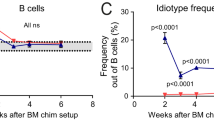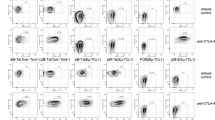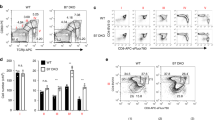Abstract
Myelin basic protein–specific CD8+ T cells can induce central nervous system autoimmunity; however, immune tolerance prevents these autoreactive cells from causing disease. To define the mechanisms that mediate tolerance, we developed two T cell receptor–transgenic mouse lines with different affinities for the H-2Kk-restricted myelin basic protein epitope consisting of amino acids 79–87 (MBP(79–87)). We observed both thymic deletion and peripheral tolerance in the lower-affinity T cells. The higher-affinity T cells, however, showed no evidence of tolerance induction and were able to prevent tolerance of the lower-affinity T cells by removing H-2Kk–MBP(79–87) complexes from antigen-presenting cells without proliferating. This form of immune regulation could limit responses of self-reactive T cells that escape other tolerance mechanisms.
This is a preview of subscription content, access via your institution
Access options
Subscribe to this journal
Receive 12 print issues and online access
$209.00 per year
only $17.42 per issue
Buy this article
- Purchase on SpringerLink
- Instant access to full article PDF
Prices may be subject to local taxes which are calculated during checkout







Similar content being viewed by others
References
Starr, T.K., Jameson, S.C. & Hogquist, K.A. Positive and negative selection of T cells. Annu. Rev. Immunol. 21, 139–176 (2003).
Walker, L.S. & Abbas, A.K. The enemy within: keeping self-reactive T cells at bay in the periphery. Nat. Rev. Immunol. 2, 11–19 (2002).
Steinman, L. Multiple sclerosis: a coordinated immunological attack against myelin in the central nervous system. Cell 85, 299–302 (1996).
Martin, R. & McFarland, H.F. in Multiple Sclerosis: Clinical and Pathogenetic Basis (eds. Raine, C..S., McFarland, H.F. & Tourtellotte, W.W.) 221–242 (Chapman and Hall, London, 1997).
Hellings, N., Raus, J. & Stinissen, P. Insights into the immunopathogenesis of multiple sclerosis. Immunol. Res. 25, 27–51 (2002).
Martin, R. & McFarland, H.F. Immunological aspects of experimental allergic encephalomyelitis and multiple sclerosis. Crit. Rev. Clin. Lab. Sci. 321, 121–182 (1995).
Zamvil, S.S. & Steinman, L. The T lymphocyte in experimental allergic encephalomyelitis. Annu. Rev. Immunol. 8, 579–621 (1990).
Gay, F.W., Drye, T.J., Dick, G.W. & Esiri, M.M. The application of multifactorial cluster analysis in the staging of plaques in early multiple sclerosis. Identification and characterization of the primary demyelinating lesion. Brain 120, 1461–1483 (1997).
Babbe, H. et al. Clonal expansions of CD8+ T cells dominate the T cell infiltrate in active multiple sclerosis lesions as shown by micromanipulation and single cell polymerase chain reaction. J. Exp. Med. 192, 393–404 (2000).
Jacobsen, M. et al. Oligoclonal expansion of memory CD8+ T cells in cerebrospinal fluid from multiple sclerosis patients. Brain 125, 538–550 (2002).
Lemke, G. Unwrapping the genes of myelin. Neuron 1, 535–543 (1988).
Jurewicz, A., Biddison, W.E. & Antel, J.P. MHC class I-restricted lysis of human oligodendrocytes by myelin basic protein peptide-specific CD8 T lymphocytes. J. Immunol. 160, 3056–3059 (1998).
Huseby, E.S., Ohlen, C. & Goverman, J. Cutting edge: myelin basic protein-specific cytotoxic T cell tolerance is maintained in vivo by a single dominant epitope in H-2k mice. J. Immunol. 163, 1115–1118 (1999).
Huseby, E.S. et al. A pathogenic role for myelin-specific CD8+ T cells in a model for multiple sclerosis. J. Exp. Med. 194, 669–676 (2001).
de Ferra, F. et al. Alternative splicing accounts for the four forms of myelin basic protein. Cell 43, 721–727 (1985).
Campagnoni, A.T. et al. Structure and developmental regulation of Golli-mbp, a 105-kilobase gene that encompasses the myelin basic protein gene and is expressed in cells in the oligodendrocyte lineage in the brain. J. Biol. Chem. 268, 4930–4938 (1993).
Mathisen, P.M., Pease, S., Garvey, J., Hood, L. & Readhead, C. Identification of an embryonic isoform of myelin basic protein that is expressed widely in the mouse embryo. Proc. Natl. Acad. Sci. USA 90, 10125–10129 (1993).
Grima, B., Zelenika, D. & Pessac, B. A novel transcript overlapping the myelin basic protein gene. J. Neurochem. 59, 2318–2323 (1992).
Zelenika, D., Grima, B. & Pessac, B. A new family of transcripts of the myelin basic protein gene: expression in brain and in immune system. J. Neurochem. 60, 1574–1577 (1993).
Givogri, M.I., Bongarzone, E.R. & Campagnoni, A.T. New insights on the biology of myelin basic protein gene: the neural-immune connection. J. Neurosci. Res. 59, 153–159 (2000).
Huseby, E.S., Sather, B., Huseby, P.G. & Goverman, J. Age-dependent T cell tolerance and autoimmunity to myelin basic protein. Immunity 14, 471–481 (2001).
Feng, J.M. et al. Thymocytes express the golli products of the myelin basic protein gene and levels of expression are stage dependent. J. Immunol. 165, 5443–5450 (2000).
Roach, A., Takahashi, N., Pravtcheva, D., Ruddle, F. & Hood, L. Chromosomal mapping of mouse myelin basic protein gene and structure and transcription of the partially deleted gene in shiverer mutant mice. Cell 42, 149–155 (1985).
MacDonald, H.R., Budd, R.C. & Howe, R.C. A CD3-subset of CD4−8+ thymocytes: a rapidly cycling intermediate in the generation of CD4+8+ cells. Eur. J. Immunol. 18, 519–523 (1988).
Nikolic-Zugic, J., Moore, M.W. & Bevan, M.J. Characterization of the subset of immature thymocytes which can undergo rapid in vitro differentiation. Eur. J. Immunol. 19, 649–653 (1989).
Shortman, K., Wilson, A., Egerton, M., Pearse, M. & Scollay, R. Immature CD4−CD8+ murine thymocytes. Cell. Immunol. 113, 462–479 (1988).
Kishimoto, H., Surh, C.D. & Sprent, J. A role for Fas in negative selection of thymocytes in vivo. J. Exp. Med. 187, 1427–1438 (1998).
Barbarese, E., Carson, J.H. & Braun, P.E. Accumulation of the four myelin basic proteins in mouse brain during development. J. Neurochem. 31, 779–782 (1978).
Voskuhl, R.R. et al. Experimental autoimmune encephalomyelitis relapses are reduced in heterozygous golli MBP knockout mice. J. Neuroimmunol. 139, 44–50 (2003).
Seamons, A. et al. Competition between two MHC binding registers in a single peptide processed from myelin basic protein influences tolerance and susceptibility to autoimmunity. J. Exp. Med. 197, 1391–1397 (2003).
Kisielow, P. et al. Tolerance in T-cell receptor transgenic mice involves deletion of nonmature CD4+CD8+ thymocytes. Nature 333, 742–746 (1988).
Sha, W.C. et al. Positive and negative selection of an antigen receptor on T cells in transgenic mice. Nature 336, 73–76 (1988).
Pircher, H., Burki, K., Lang, R., Hengartner, H. & Zinkernagel, R.M. Tolerance induction in double specific T-cell receptor transgenic mice varies with antigen. Nature 342, 559–561 (1989).
Auphan, N. et al. Influence of antigen density on degree of clonal deletion in T cell receptor transgenic mice. Int. Immunol. 4, 541–547 (1992).
Auphan, N. et al. The degree of CD8 dependence of cytolytic T cell precursors is determined by the nature of the T cell receptor (TCR) and influences negative selection in TCR-transgenic mice. Eur. J. Immunol. 24, 1572–1577 (1994).
Kedl, R.M., Schaefer, B.C., Kappler, J.W. & Marrack, P. T cells down-modulate peptide-MHC complexes on APCs in vivo. Nat. Immunol. 3, 27–32 (2002).
Zhumabekov, T., Corbella, P., Tolaini, M. & Kioussis, D. Improved version of a human CD2 minigene based vector for T cell-specific expression in transgenic mice. J. Immunol. Meth. 185, 133–140 (1995).
Burgert, H.G., White, J., Weltzien, H.U., Marrack, P. & Kappler, J.W. Reactivity of Vβ17a+ CD8+ T cell hybrids. Analysis using a new CD8+ T cell fusion partner. J. Exp. Med. 170, 1887–1904 (1989).
Acknowledgements
We thank N. Mausolf and M. Ottele for animal husbandry and technical support; A. Seamons for assistance with DC purifications; and E. Huseby for generation of cytotoxic T lymphocyte lines. We also thank T. Brabb, S. Cabbage, E. Huseby and A. Seamons for critical reading of the manuscript and discussions. Supported by National Institutes of Health (NS35126 and NS43417 to J.G.) and Public Health Service (T32 GM07270 to A.P.).
Author information
Authors and Affiliations
Corresponding author
Ethics declarations
Competing interests
The authors declare no competing financial interests.
Rights and permissions
About this article
Cite this article
Perchellet, A., Stromnes, I., Pang, J. et al. CD8+ T cells maintain tolerance to myelin basic protein by 'epitope theft'. Nat Immunol 5, 606–614 (2004). https://doi.org/10.1038/ni1073
Received:
Accepted:
Published:
Issue Date:
DOI: https://doi.org/10.1038/ni1073



